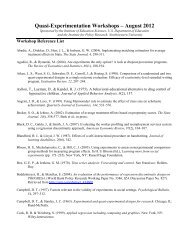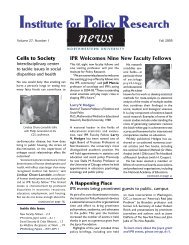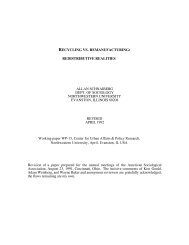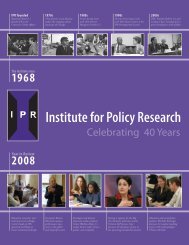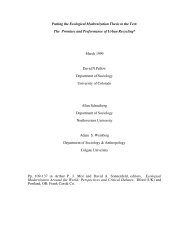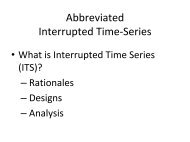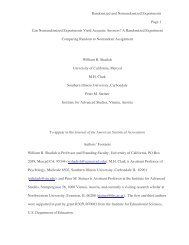pdf - Institute for Policy Research - Northwestern University
pdf - Institute for Policy Research - Northwestern University
pdf - Institute for Policy Research - Northwestern University
You also want an ePaper? Increase the reach of your titles
YUMPU automatically turns print PDFs into web optimized ePapers that Google loves.
P. Reese<br />
is financed by the sale of a profitable<br />
“revenue” good. An implication of<br />
this model is that nonprofit and public<br />
universities will act as profit maximizers,<br />
like private firms, in the revenue-good<br />
markets, but systematically differently<br />
in mission-good markets. This project is<br />
supported by the Spencer Foundation.<br />
Healthcare Industry<br />
The vast majority of Americans purchase<br />
health insurance through the private<br />
sector. Moreover, in recent years the<br />
public sector has increasingly turned to<br />
private insurers to deliver some or all<br />
of their commitments to enrollees. In<br />
spite of the enormous sums of public<br />
and private funds entrusted to these<br />
insurance carriers, there is little systematic<br />
research about them. Using a privately<br />
gathered national database of insurance<br />
contracts from a sample of large, multisite<br />
employers, economist Leemore Dafny<br />
investigates whether these markets are<br />
competitive by examining insurance<br />
carriers’ pricing. She finds insurers are<br />
successfully charging higher premiums to<br />
more profitable firms, and such markups<br />
are frequent in markets with little<br />
competition. This suggests that, at least<br />
in some markets, imperfect competition<br />
among carriers is leading to higher health<br />
insurance premiums.<br />
In other recent work, Dafny explores<br />
whether hospital managers face pressure<br />
to maximize reimbursement by exploiting<br />
loopholes in government insurance<br />
programs. A 1988 change in Medicare<br />
rules widened a pre-existing loophole<br />
in the Medicare payment system. This<br />
gave hospitals an opportunity to increase<br />
operating margins by more than 5<br />
percent simply by “upcoding” patients<br />
to codes <strong>for</strong> more expensive procedures.<br />
Dafny and her colleague, David Dranove,<br />
find that “room to upcode” is a significant<br />
predictor of whether a nonprofit hospital<br />
replaces its management with a new team<br />
of <strong>for</strong>-profit managers. They also find<br />
that hospitals replacing their managers<br />
subsequently upcode more than a sample<br />
of similar hospitals that did not.<br />
Weisbrod is researching behavioral<br />
differences among <strong>for</strong>-profit, public,<br />
religious nonprofit, and secular nonprofit<br />
hospitals, examining differences<br />
in public-goods<br />
provision—charity<br />
care, research, and<br />
education—over<br />
21 years <strong>for</strong> all<br />
Cali<strong>for</strong>nia hospitals.<br />
Weisbrod has also<br />
been investigating<br />
market change<br />
<strong>for</strong> brand-name<br />
and generic drugs<br />
between 1970 and<br />
2004. In looking<br />
at the 50 mostdispensed<br />
drugs question during his presentation on age and choice<br />
Peter Zweifel of the <strong>University</strong> of Zurich takes a<br />
each year and when<br />
in social insurance.<br />
new drugs first<br />
appear on the list, he finds a substantial<br />
increase in the number of new brandname<br />
drugs on the most-dispensed lists.<br />
Between 1970 and 1981, 6 to 8 percent<br />
of all brand-name drugs on the mostdispensed<br />
list were new each year. In the<br />
past decade, however, it has increased<br />
to more than 10 percent. At the same<br />
time, the quantitative importance of<br />
generic drugs, and of new generics, grew<br />
especially sharply, particularly since 1985.<br />
These reveal a picture of quantitative<br />
change over time, an especially important<br />
consideration given how much brandname<br />
pharmaceuticals are increasing as<br />
a slice of total healthcare expenditures,<br />
despite the growth of low-cost generic<br />
drugs. These measures do not capture the<br />
medical importance of a new drug, except<br />
by usage, but they do reflect a way to<br />
measure available and widely used drugs.<br />
www.northwestern.edu/ipr 33






